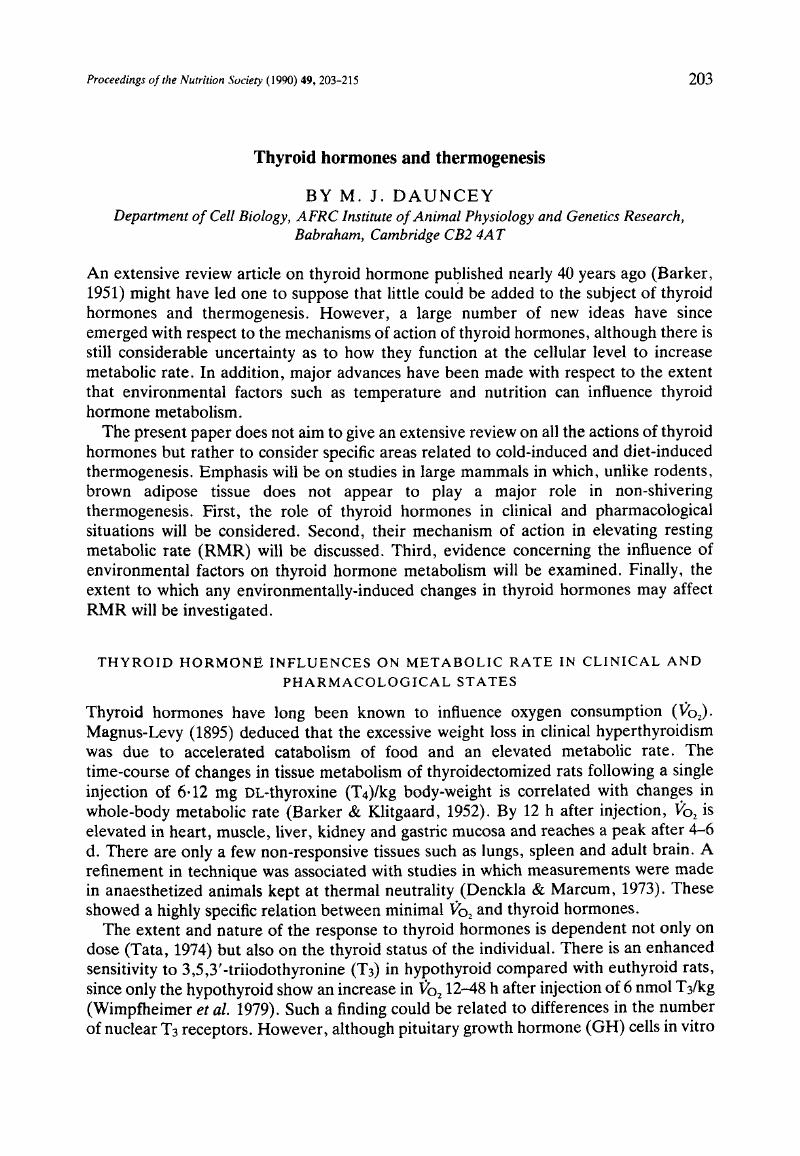Crossref Citations
This article has been cited by the following publications. This list is generated based on data provided by Crossref.
Norgan, N. G.
1990.
Thermogenesis Above Maintenance in Humans.
Proceedings of the Nutrition Society,
Vol. 49,
Issue. 2,
p.
217.
Dauncey, M.J.
1991.
Whole-body calorimetry in man and animals.
Thermochimica Acta,
Vol. 193,
Issue. ,
p.
1.
BRAND, Martin D.
STEVERDING, Dietmar
KADENBACH, Bernhard
STEVENSON, Patricia M.
and
HAFNER, Roderick P.
1992.
The mechanism of the increase in mitochondrial proton permeability induced by thyroid hormones.
European Journal of Biochemistry,
Vol. 206,
Issue. 3,
p.
775.
Harper, Mary-Ellen
and
Brand, Martin D.
1993.
Modern Trends in Biothermokinetics.
p.
351.
Harper, M.E.
and
Brand, M.D.
1993.
The quantitative contributions of mitochondrial proton leak and ATP turnover reactions to the changed respiration rates of hepatocytes from rats of different thyroid status.
Journal of Biological Chemistry,
Vol. 268,
Issue. 20,
p.
14850.
SILVA, J. ENRIQUE
1995.
Thyroid Hormone Control of Thermogenesis and Energy Balance.
Thyroid,
Vol. 5,
Issue. 6,
p.
481.
Symonds, Michael E.
1995.
Pregnancy, parturition and neonatal development: interactions between nutrition and thyroid hormones.
Proceedings of the Nutrition Society,
Vol. 54,
Issue. 2,
p.
329.
Symonds, M. E.
1995.
Thyroid hormones and nutrient supplementation during pregnancy.
Equine Veterinary Education,
Vol. 7,
Issue. 5,
p.
246.
Clarke, Lynne
Bird, Jane A
Lomax, Michael A
and
Symonds, Michael E
1996.
Effect of β3-Adrenergic Agonist (Zeneca D7114) on Thermoregulation in Near-Term Lambs Delivered by Cesarean Section.
Pediatric Research,
Vol. 40,
Issue. 2,
p.
330.
Harrison, A. P.
Tivey, D. R.
Clausen, T.
Duchamp, C.
and
Dauncey, M. J.
1996.
Role of thyroid hormones in early postnatal development of skeletal muscle and its implications for undernutrition.
British Journal of Nutrition,
Vol. 76,
Issue. 6,
p.
841.
Symonds, Michael E.
and
Clarke, Lynne
1996.
Nutrition-Environment Interactions in Pregnancy.
Nutrition Research Reviews,
Vol. 9,
Issue. 1,
p.
135.
Kemp, Richard B.
1996.
Cell Chemistry and Physiology: Part III.
Vol. 4,
Issue. ,
p.
303.
Sjödin, A.
Forslund, A.
Webb, P.
and
Hambræus, L.
1996.
Mild overcooling increases energy expenditure during endurance exercise.
Scandinavian Journal of Medicine & Science in Sports,
Vol. 6,
Issue. 1,
p.
22.
Dauncey, M. J.
and
Gilmour, R. S.
1996.
Regulatory factors in the control of muscle development.
Proceedings of the Nutrition Society,
Vol. 55,
Issue. 1B,
p.
543.
Symonds, Michael E.
and
Clarke, Lynne
1996.
Influence of thyroid hormones and temperature on adipose tissue development and lung maturation.
Proceedings of the Nutrition Society,
Vol. 55,
Issue. 1B,
p.
561.
Ulijaszek, Stanley J.
1996.
Energetics, adaptation, and adaptability.
American Journal of Human Biology,
Vol. 8,
Issue. 2,
p.
169.
Brigham, Dale
Beard, John
and
Tobin, Brian
1996.
Iron and thermoregulation: A review.
Critical Reviews in Food Science and Nutrition,
Vol. 36,
Issue. 8,
p.
747.
Dauncey, M. J.
1997.
From early nutrition and later development...to underlying mechanisms and optimal health.
British Journal of Nutrition,
Vol. 78,
Issue. s2,
p.
S113.
NEDERGAARD, JAN
DICKER, ANDREA
and
CANNON, BARBARA
1997.
The Interaction between Thyroid and Brown‐Fat Thermogenesis.
Annals of the New York Academy of Sciences,
Vol. 813,
Issue. 1,
p.
712.
OUSEY, JENNIFER C.
1997.
Thermoregulation and the energy requirement of the newborn foal, with reference to prematurity.
Equine Veterinary Journal,
Vol. 29,
Issue. S24,
p.
104.



